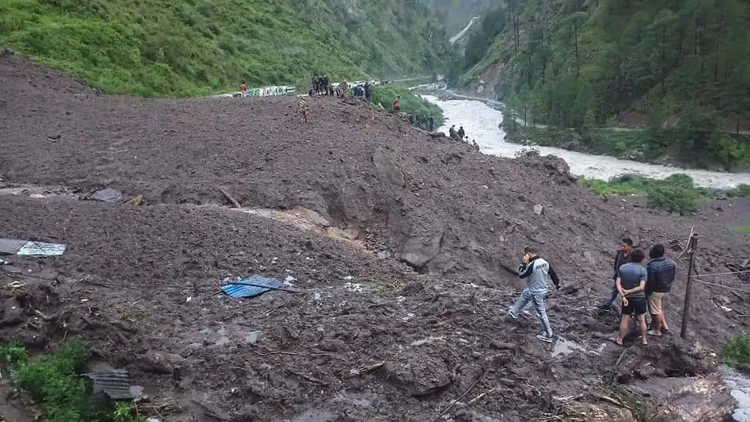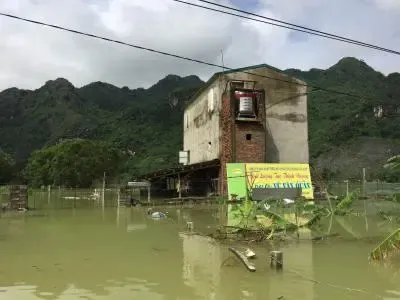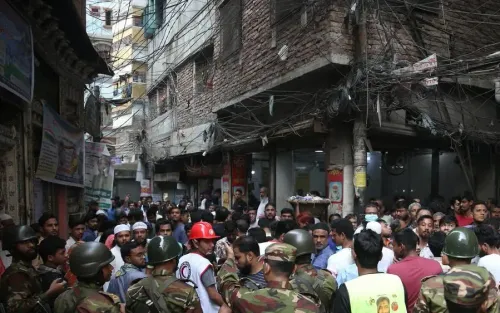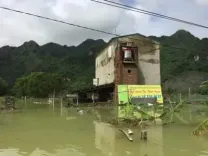What Happened in Nepal as Landslides Claim 14 Lives?

Synopsis
Key Takeaways
- 14 fatalities confirmed in Ilam district due to landslides.
- Heavy rainfall has caused significant infrastructure damage.
- Major highways are blocked, disrupting transportation.
- Government urges citizens to stay indoors amid ongoing weather warnings.
- Efforts are underway to assess and address the situation.
Kathmandu, Oct 5 (NationPress) - In a devastating incident, at least 14 individuals lost their lives due to landslides caused by relentless rainfall in Nepal's Ilam district, according to local officials.
The nation has been experiencing severe downpours since Friday, leading to landslides, flooding, and submersion in various regions.
Notably, Ilam, which shares a border with Darjeeling, India, has reported the highest number of fatalities.
Sunita Nepal, the Chief District Officer of Ilam, informed IANS that at least 14 people have been confirmed dead after landslides buried three homes on Saturday evening.
She expressed concern, stating, "With further damage to residences in the district, the death toll may increase." The District Administration Office (DAO), Ilam, has requested comprehensive reports on the damages incurred due to the landslides and flooding from local government authorities.
According to DAO, the continuous precipitation over the last three days has resulted in both human casualties and extensive destruction to public infrastructure, including roads.
The Mechi Highway, which links Ilam to the southern Jhapa district, has been obstructed at numerous locations due to landslides.
Despite the heavy rains since Friday, conditions improved slightly by Sunday morning, as reported by the Department of Hydrology and Meteorology.
In a notice released on Sunday, the department stated that rainfall had diminished in most districts, with the most significant amounts recorded in certain areas of Lalitpur district in the Kathmandu Valley.
"Light rain is occurring in several areas including Kathmandu, Morang, Sunsari, Udayapur, Saptari, Siraha, Dhanusha, Sarlahi, Sindhuli, and Ramechhap districts," the department indicated.
Nonetheless, it cautioned about the potential for heavy rainfall in the hilly regions of eastern Koshi Province later on Sunday.
Although precipitation has lessened in various districts by Sunday morning, landslides have damaged multiple highways, disrupting transport services.
The Nepalese government has maintained its restrictions on vehicle movement to and from Kathmandu Valley.
The Metropolitan Traffic Police Division reported that major highways connecting the Valley – including the Prithvi Highway (linking Kathmandu with western Nepal), the BP Highway (connecting the capital with southeastern Nepal), and the Araniko Highway (linking Kathmandu with the Chinese border) – are completely blocked.
Additionally, the Pasang Lhamu, Koshi, and Siddhicharan highways are also entirely obstructed.
Given the risks posed by landslides and flooding, long-distance transport services from five out of the seven provinces – Koshi, Madhesh, Bagmati, Gandaki, and Lumbini – have been halted, as stated by the Metropolitan Traffic Police Division in a social media update on Sunday.
In a video address to the nation on Saturday evening, Nepal's interim Prime Minister, Sushila Karki, urged citizens to remain indoors and avoid unnecessary travel as heavy rains continue to impact various regions of the country.
She assured that the government would mobilize all available resources to ensure the safety of citizens during this ongoing natural disaster.









